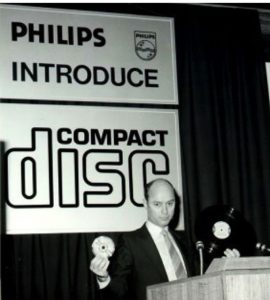History (1979): Philips Demonstrates Digital Compact Disc
CD-ROM emerges for software and video game distribution.
This is a Press Release edited by StorageNewsletter.com on May 4, 2018 at 2:02 pmThis article comes from the Computer History Museum.
1979: Philips demonstrates digital compact disc
CD-ROM emerges for software & video game distribution
Joop Sinjou of Philips introduces the music

In 1974 Philips researchers combined optical readout and digital encoding techniques to adapt the analog laser disc for digital audio applications.
N.V. Philips’ Gloeilampenfabrieken revealed the compact disc (CD) and player to the press in Eindhoven, Holland in March 1979.
As Sony had developed similar technology, the companies cooperated to standardize around a 12cm diameter disc, as required to accommodate Beethoven’s 74-minute Ninth Symphony, and in 1982 Sony released the CDP-101 commercial CD player priced at 168,000 yen (about $1,200 in 2012).
Stimulated by automobile and battery-operated portable players, by 1988 CD music unit sales surpassed those of vinyl albums.
Recognizing a potential 800MB storage capacity compared to 1MB on a standard floppy disk, DEC worked with Sony and Philips to improve the data integrity of the CD for computer ROM applications. In 1984 DEC introduced the first computer connected CD-ROM player from a major systems manufacturer; the Philips designed RRD-50 (Philips LMSI CM100). Distribution of DEC ULTRIX (UNIX) on CDs paved the way for widespread adoption of the format for commercial software, games, and educational material.
In 1985, CD-ROM discs containing government, medical, and demographic databases began to appear and Gary Kildall, who had earlier ported the title to a Pioneer LaserDisk, worked with Grolier to produce the Academic American Encyclopedia on CD-ROM.
In 1992 Apple introduced optional internal CD-ROM drives and Sega offered a high-end video game console, but Sony’s 1994 Play Station aimed at more casual users established the technology in the mainstream of the video game industry.
The development of recordable compact discs led to the final obsolescence of the floppy disc.













 Subscribe to our free daily newsletter
Subscribe to our free daily newsletter

